Philips V60 User Manual
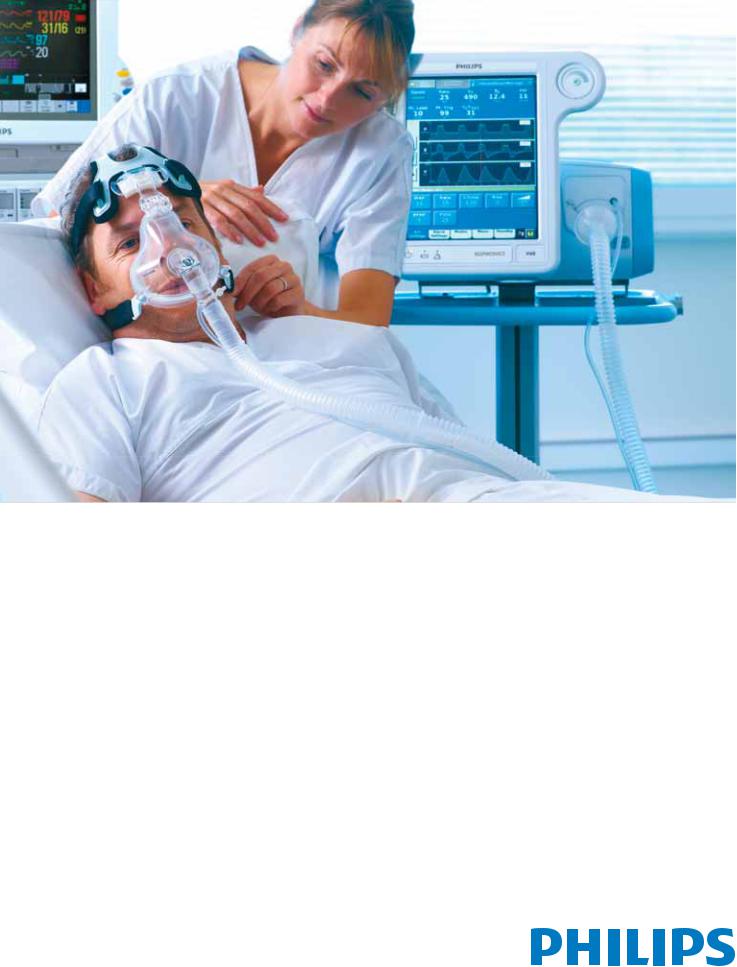
Respironics V60 Ventilator
User Manual

For Technical Support and Customer Service, contact:
USA and Canada: 800-345-6443 or 724-387-4000
Respironics Europe, Africa, Middle East: +33-1-47-52-30-00
Respironics Asia Pacific: +852-3194-2280
Facsimile: +1-724-387-5012
USA
Respironics California, Inc.
2271 Cosmos Court
Carlsbad, CA 92011
Email and web addresses service@philips.com clinical@philips.com www.philips.com\healthcare
Authorized European representative
Respironics Deutschland GmbH Gewerbestrasse 17
D-82211 Herrsching Germany +49-8-15-29-30-60
© 2009 Respironics and its affiliates. All rights reserved.
This work is protected under Title 17 of the United States copyright code and is the sole property of Respironics. No part of this document may be copied or otherwise reproduced, or stored in any electronic information retrieval system, except as specifically permitted under United States copyright law, without the prior written consent of Respironics.

Table of contents
1. Warnings, cautions, and notes . . . . . . . . . . . . . . . . . . . . . . . . . . . . . . . 1-1
Definitions . . . . . . . . . . . . . . . . . . . . . . . . . . . . . . . . . . . . . . . . . . . . 1-1 General. . . . . . . . . . . . . . . . . . . . . . . . . . . . . . . . . . . . . . . . . . . . . . . 1-1 Preparing for ventilation . . . . . . . . . . . . . . . . . . . . . . . . . . . . . . . . . . . 1-3 Operation . . . . . . . . . . . . . . . . . . . . . . . . . . . . . . . . . . . . . . . . . . . . . 1-5 Alarms and messages. . . . . . . . . . . . . . . . . . . . . . . . . . . . . . . . . . . . . 1-5 Care and maintenance . . . . . . . . . . . . . . . . . . . . . . . . . . . . . . . . . . . . 1-5 First-time installation . . . . . . . . . . . . . . . . . . . . . . . . . . . . . . . . . . . . . 1-6 Communications interface . . . . . . . . . . . . . . . . . . . . . . . . . . . . . . . . . 1-7 Diagnostic mode . . . . . . . . . . . . . . . . . . . . . . . . . . . . . . . . . . . . . . . . 1-7
2. Symbols . . . . . . . . . . . . . . . . . . . . . . . . . . . . . . . . . . . . . . . . . . . . . . . 2-9 3. General information . . . . . . . . . . . . . . . . . . . . . . . . . . . . . . . . . . . . . . . 3-1
Intended use . . . . . . . . . . . . . . . . . . . . . . . . . . . . . . . . . . . . . . . . . . . |
3-1 |
About CO2 rebreathing . . . . . . . . . . . . . . . . . . . . . . . . . . . . . . . . . . . . |
3-1 |
Potential side effects . . . . . . . . . . . . . . . . . . . . . . . . . . . . . . . . . . . . . |
3-1 |
Contraindications. . . . . . . . . . . . . . . . . . . . . . . . . . . . . . . . . . . . . . . . |
3-2 |
General description . . . . . . . . . . . . . . . . . . . . . . . . . . . . . . . . . . . . . . |
3-2 |
Physical description . . . . . . . . . . . . . . . . . . . . . . . . . . . . . . . . . . . . . . |
3-4 |
Patient circuits, masks/patient interfaces, and accessories . . . . . . . |
3-4 |
Ventilator unit . . . . . . . . . . . . . . . . . . . . . . . . . . . . . . . . . . . . . . |
3-6 |
Graphical user interface . . . . . . . . . . . . . . . . . . . . . . . . . . . . . . . |
3-9 |
4. Principles of operation. . . . . . . . . . . . . . . . . . . . . . . . . . . . . . . . . . . . . 4-1
System operational overview . . . . . . . . . . . . . . . . . . . . . . . . . . . . . . . . 4-1 Pneumatic system operation . . . . . . . . . . . . . . . . . . . . . . . . . . . . . . . . 4-2 Breath delivery characteristics . . . . . . . . . . . . . . . . . . . . . . . . . . . . . . 4-2 Control variable . . . . . . . . . . . . . . . . . . . . . . . . . . . . . . . . . . . . . 4-2 Triggering, cycling, and leak adaptation . . . . . . . . . . . . . . . . . . . . 4-2 Baseline pressure . . . . . . . . . . . . . . . . . . . . . . . . . . . . . . . . . . . . 4-2 Pressure rise time . . . . . . . . . . . . . . . . . . . . . . . . . . . . . . . . . . . . 4-3 Negative pressures . . . . . . . . . . . . . . . . . . . . . . . . . . . . . . . . . . . 4-3 Oxygen concentration . . . . . . . . . . . . . . . . . . . . . . . . . . . . . . . . . 4-3 Auto-Trak Sensitivity . . . . . . . . . . . . . . . . . . . . . . . . . . . . . . . . . . . . . 4-3 Triggering . . . . . . . . . . . . . . . . . . . . . . . . . . . . . . . . . . . . . . . . . . 4-3 Cycling . . . . . . . . . . . . . . . . . . . . . . . . . . . . . . . . . . . . . . . . . . . 4-3 Leak adaptation . . . . . . . . . . . . . . . . . . . . . . . . . . . . . . . . . . . . . 4-5 Ventilation modes . . . . . . . . . . . . . . . . . . . . . . . . . . . . . . . . . . . . . . . 4-7 CPAP mode . . . . . . . . . . . . . . . . . . . . . . . . . . . . . . . . . . . . . . . . 4-8 PCV mode . . . . . . . . . . . . . . . . . . . . . . . . . . . . . . . . . . . . . . . . . 4-9 S/T mode . . . . . . . . . . . . . . . . . . . . . . . . . . . . . . . . . . . . . . . . . 4-10 AVAPS mode (optional) . . . . . . . . . . . . . . . . . . . . . . . . . . . . . . . 4-11
1047358 Rev A |
Respironics V60 Ventilator User Manual |
iii |

Table of contents |
|
|
5. |
Preparing for ventilation . . . . . . . . . . . . . . . . . . . . . . . . . . . . . . . . . . . |
5-1 |
Connecting external devices . . . . . . . . . . . . . . . . . . . . . . . . . . . . . . . . . 5-1
Connecting oxygen. . . . . . . . . . . . . . . . . . . . . . . . . . . . . . . . . . . . . . . . 5-1
Installing the patient circuit . . . . . . . . . . . . . . . . . . . . . . . . . . . . . . . . . 5-2
Connecting to AC power . . . . . . . . . . . . . . . . . . . . . . . . . . . . . . . . . . . . 5-4
About the optional backup battery . . . . . . . . . . . . . . . . . . . . . . . . . . . . . 5-4
Starting up the ventilator . . . . . . . . . . . . . . . . . . . . . . . . . . . . . . . . . . . 5-6
Shutting down the ventilator . . . . . . . . . . . . . . . . . . . . . . . . . . . . . . . . . 5-6
Navigating the graphical user interface . . . . . . . . . . . . . . . . . . . . . . . . . 5-7
Preoperational check . . . . . . . . . . . . . . . . . . . . . . . . . . . . . . . . . . . . . . 5-8
Required materials . . . . . . . . . . . . . . . . . . . . . . . . . . . . . . . . . . . . 5-8
Procedure . . . . . . . . . . . . . . . . . . . . . . . . . . . . . . . . . . . . . . . . . . 5-8
Troubleshooting . . . . . . . . . . . . . . . . . . . . . . . . . . . . . . . . . . . . . . 5-9
Alarm tests . . . . . . . . . . . . . . . . . . . . . . . . . . . . . . . . . . . . . . . . . . . . 5-10
Preparation . . . . . . . . . . . . . . . . . . . . . . . . . . . . . . . . . . . . . . . . 5-10
High Inspiratory Pressure . . . . . . . . . . . . . . . . . . . . . . . . . . . . . . . 5-10
Low Tidal Volume . . . . . . . . . . . . . . . . . . . . . . . . . . . . . . . . . . . . 5-10
Patient Disconnect . . . . . . . . . . . . . . . . . . . . . . . . . . . . . . . . . . . 5-11
Patient Circuit Occluded . . . . . . . . . . . . . . . . . . . . . . . . . . . . . . . 5-11
6. Operation . . . . . . . . . . . . . . . . . . . . . . . . . . . . . . . . . . . . . . . . . . . . . . 6-1
Changing the mode . . . . . . . . . . . . . . . . . . . . . . . . . . . . . . . . . . . . . . . 6-2 Changing control settings . . . . . . . . . . . . . . . . . . . . . . . . . . . . . . . . . . . 6-3 Making batch setting changes . . . . . . . . . . . . . . . . . . . . . . . . . . . . 6-3 Changing individual ventilator settings . . . . . . . . . . . . . . . . . . . . . . 6-4 Using the Ramp Time function . . . . . . . . . . . . . . . . . . . . . . . . . . . . . . . 6-5 Changing alarm settings . . . . . . . . . . . . . . . . . . . . . . . . . . . . . . . . . . . . 6-6 Selecting the mask and exhalation port . . . . . . . . . . . . . . . . . . . . . . . . . 6-7 Running the exhalation port test . . . . . . . . . . . . . . . . . . . . . . . . . . . . . 6-10 Procedure . . . . . . . . . . . . . . . . . . . . . . . . . . . . . . . . . . . . . . . . . 6-10 Troubleshooting . . . . . . . . . . . . . . . . . . . . . . . . . . . . . . . . . . . . . 6-11 Other functions: the Menu window . . . . . . . . . . . . . . . . . . . . . . . . . . . 6-11 Brightness . . . . . . . . . . . . . . . . . . . . . . . . . . . . . . . . . . . . . . . . . 6-11 Loudness . . . . . . . . . . . . . . . . . . . . . . . . . . . . . . . . . . . . . . . . . . 6-11 Mask/Port . . . . . . . . . . . . . . . . . . . . . . . . . . . . . . . . . . . . . . . . . 6-11 Vent Info (ventilator information) . . . . . . . . . . . . . . . . . . . . . . . . . 6-11 Screen Lock . . . . . . . . . . . . . . . . . . . . . . . . . . . . . . . . . . . . . . . . 6-12 Standby . . . . . . . . . . . . . . . . . . . . . . . . . . . . . . . . . . . . . . . . . . . . . . 6-12 Help function . . . . . . . . . . . . . . . . . . . . . . . . . . . . . . . . . . . . . . . . . . 6-14 Table of modes and control settings . . . . . . . . . . . . . . . . . . . . . . . . . . 6-15
7. Patient monitoring. . . . . . . . . . . . . . . . . . . . . . . . . . . . . . . . . . . . . . . . 7-1
Display conventions . . . . . . . . . . . . . . . . . . . . . . . . . . . . . . . . . . . . . . . 7-1 Table of monitored parameters . . . . . . . . . . . . . . . . . . . . . . . . . . . . . . . 7-2 Scaling the waveform axes . . . . . . . . . . . . . . . . . . . . . . . . . . . . . . . . . . 7-2 Freezing and unfreezing waveforms . . . . . . . . . . . . . . . . . . . . . . . . . . . . 7-3
iv |
Respironics V60 Ventilator User Manual |
1047358 Rev A |

Table of contents
8. Alarms and messages . . . . . . . . . . . . . . . . . . . . . . . . . . . . . . . . . . . . . 8-1
Responding to alarms. . . . . . . . . . . . . . . . . . . . . . . . . . . . . . . . . . . . . 8-1 Setting alarm loudness. . . . . . . . . . . . . . . . . . . . . . . . . . . . . . . . . . . . 8-4 Silencing alarms . . . . . . . . . . . . . . . . . . . . . . . . . . . . . . . . . . . . . . . . 8-5 Resetting alarms . . . . . . . . . . . . . . . . . . . . . . . . . . . . . . . . . . . . . . . . 8-5 Manually resetting alarms . . . . . . . . . . . . . . . . . . . . . . . . . . . . . . 8-5 Clearing autoreset alarms from the Alarms list . . . . . . . . . . . . . . . . 8-5 Hiding/displaying alarm messages . . . . . . . . . . . . . . . . . . . . . . . . . . . . 8-6 Alarms and other messages. . . . . . . . . . . . . . . . . . . . . . . . . . . . . . . . . 8-6
9. Care and maintenance . . . . . . . . . . . . . . . . . . . . . . . . . . . . . . . . . . . . . 9-1
Decontamination . . . . . . . . . . . . . . . . . . . . . . . . . . . . . . . . . . . . . . . . |
9-1 |
Ventilator exterior . . . . . . . . . . . . . . . . . . . . . . . . . . . . . . . . . . . . |
9-1 |
Touchscreen . . . . . . . . . . . . . . . . . . . . . . . . . . . . . . . . . . . . . . . . |
9-2 |
Bacteria filter, patient circuit, and other accessories . . . . . . . . . . . |
9-2 |
Preventive maintenance . . . . . . . . . . . . . . . . . . . . . . . . . . . . . . . . . . . |
9-3 |
Replacing the air inlet filter . . . . . . . . . . . . . . . . . . . . . . . . . . . . . |
9-4 |
Cleaning or replacing the cooling fan filter . . . . . . . . . . . . . . . . . . |
9-5 |
Removing and replacing the battery . . . . . . . . . . . . . . . . . . . . . . . |
9-6 |
Disposal . . . . . . . . . . . . . . . . . . . . . . . . . . . . . . . . . . . . . . . . . . . . . . |
9-6 |
Storage . . . . . . . . . . . . . . . . . . . . . . . . . . . . . . . . . . . . . . . . . . . . . . . |
9-6 |
Repairs . . . . . . . . . . . . . . . . . . . . . . . . . . . . . . . . . . . . . . . . . . . . . . . |
9-6 |
Repacking and shipping . . . . . . . . . . . . . . . . . . . . . . . . . . . . . . . . . . . |
9-6 |
10. Technical specifications . . . . . . . . . . . . . . . . . . . . . . . . . . . . . . . . . . 10-1
Control settings . . . . . . . . . . . . . . . . . . . . . . . . . . . . . . . . . . . . . . . . 10-1 Patient data . . . . . . . . . . . . . . . . . . . . . . . . . . . . . . . . . . . . . . . . . . 10-2 Alarms . . . . . . . . . . . . . . . . . . . . . . . . . . . . . . . . . . . . . . . . . . . . . . 10-3 Menu window settings . . . . . . . . . . . . . . . . . . . . . . . . . . . . . . . . . . . 10-3 Operator-accessible diagnostic mode functions. . . . . . . . . . . . . . . . . . 10-4 Physical characteristics . . . . . . . . . . . . . . . . . . . . . . . . . . . . . . . . . . 10-4 Environmental specifications . . . . . . . . . . . . . . . . . . . . . . . . . . . . . . 10-5 Pneumatic specifications . . . . . . . . . . . . . . . . . . . . . . . . . . . . . . . . . 10-5 Electrical specifications . . . . . . . . . . . . . . . . . . . . . . . . . . . . . . . . . . 10-5 Other specifications . . . . . . . . . . . . . . . . . . . . . . . . . . . . . . . . . . . . . 10-6
A. First-time installation . . . . . . . . . . . . . . . . . . . . . . . . . . . . . . . . . . . . . . A-1
Unpacking and inspection . . . . . . . . . . . . . . . . . . . . . . . . . . . . . . . . . A-1 Mounting the ventilator . . . . . . . . . . . . . . . . . . . . . . . . . . . . . . . . . . . A-2 Installing the optional battery . . . . . . . . . . . . . . . . . . . . . . . . . . . . . . . A-3 Installing oxygen inlet connector and AC power cord (Outside the USA and Japan only) . . . . . . . . . . . . . . . . . . . . . . . . . . . . . . . . . . . . . . . . . . . . A-6 Installing the oxygen manifold kit . . . . . . . . . . . . . . . . . . . . . . . . . . . . A-7 Configuration and screen calibration . . . . . . . . . . . . . . . . . . . . . . . . . . A-7
1047358 Rev A |
Respironics V60 Ventilator User Manual |
v |

Table of contents |
|
|
B. |
Communications interface . . . . . . . . . . . . . . . . . . . . . . . . . . . . . . . . . . |
B-1 |
RS-232 serial and analog I/O port . . . . . . . . . . . . . . . . . . . . . . . . . . . . B-2
Pinout of connector . . . . . . . . . . . . . . . . . . . . . . . . . . . . . . . . . . . B-2
Communications protocol . . . . . . . . . . . . . . . . . . . . . . . . . . . . . . B-3
Commands and transmission conventions . . . . . . . . . . . . . . . . . . . B-3
Remote alarm port . . . . . . . . . . . . . . . . . . . . . . . . . . . . . . . . . . . . . . B-12
C. Warranty. . . . . . . . . . . . . . . . . . . . . . . . . . . . . . . . . . . . . . . . . . . . . . . C-1
One-year warranty . . . . . . . . . . . . . . . . . . . . . . . . . . . . . . . . . . . . . . . . C-1 Warranty limits . . . . . . . . . . . . . . . . . . . . . . . . . . . . . . . . . . . . . . . . . . C-1
D. Parts and accessories . . . . . . . . . . . . . . . . . . . . . . . . . . . . . . . . . . . . . D-1
Adult masks . . . . . . . . . . . . . . . . . . . . . . . . . . . . . . . . . . . . . . . . . . . D-1 Pediatric masks. . . . . . . . . . . . . . . . . . . . . . . . . . . . . . . . . . . . . . . . . D-3 Exhalation ports. . . . . . . . . . . . . . . . . . . . . . . . . . . . . . . . . . . . . . . . . D-3 Patient breathing circuits . . . . . . . . . . . . . . . . . . . . . . . . . . . . . . . . . . D-4 Bacteria filter . . . . . . . . . . . . . . . . . . . . . . . . . . . . . . . . . . . . . . . . . . D-4 Operator maintenance parts . . . . . . . . . . . . . . . . . . . . . . . . . . . . . . . . D-4 Other parts . . . . . . . . . . . . . . . . . . . . . . . . . . . . . . . . . . . . . . . . . . . . D-5
E. Regulatory compliance . . . . . . . . . . . . . . . . . . . . . . . . . . . . . . . . . . . . E-1
Electromagnetic compatibility (EMC) . . . . . . . . . . . . . . . . . . . . . . . . . . . E-1 Safety. . . . . . . . . . . . . . . . . . . . . . . . . . . . . . . . . . . . . . . . . . . . . . . . . E-1
F. Diagnostic mode . . . . . . . . . . . . . . . . . . . . . . . . . . . . . . . . . . . . . . . . . F-1
Entering the diagnostic mode . . . . . . . . . . . . . . . . . . . . . . . . . . . . . . . . F-1 System settings . . . . . . . . . . . . . . . . . . . . . . . . . . . . . . . . . . . . . . . . . . F-3 Language . . . . . . . . . . . . . . . . . . . . . . . . . . . . . . . . . . . . . . . . . . . F-4 Date/Time . . . . . . . . . . . . . . . . . . . . . . . . . . . . . . . . . . . . . . . . . . F-6 Pressure Units . . . . . . . . . . . . . . . . . . . . . . . . . . . . . . . . . . . . . . . F-7 Restore Default Settings . . . . . . . . . . . . . . . . . . . . . . . . . . . . . . . . F-8 Software Options . . . . . . . . . . . . . . . . . . . . . . . . . . . . . . . . . . . . . F-9 Baud Rate . . . . . . . . . . . . . . . . . . . . . . . . . . . . . . . . . . . . . . . . . F-10 Service . . . . . . . . . . . . . . . . . . . . . . . . . . . . . . . . . . . . . . . . . . . . . . . F-11 Significant Event Log . . . . . . . . . . . . . . . . . . . . . . . . . . . . . . . . . F-11 Touchscreen calibration . . . . . . . . . . . . . . . . . . . . . . . . . . . . . . . . . . . F-13 Exiting the diagnostic mode . . . . . . . . . . . . . . . . . . . . . . . . . . . . . . . . F-13
Glossary . . . . . . . . . . . . . . . . . . . . . . . . . . . . . . . . . . . . . . . . . . Glossary-1
Index . . . . . . . . . . . . . . . . . . . . . . . . . . . . . . . . . . . . . . . . . . . . . . Index-1
vi |
Respironics V60 Ventilator User Manual |
1047358 Rev A |

Chapter 1. Warnings, cautions, and notes
Definitions
General
Before using the Respironics V60 Ventilator on a patient, familiarize yourself with this user manual, particularly the safety considerations listed. Be aware, however, that this manual is a reference only. It is not intended to supersede your institution’s protocol regarding the safe use of assisted ventilation.
WARNING: Alerts the user to the possibility of injury, death, or other serious adverse reactions associated with the use or misuse of the device.
CAUTION: Alerts the user to the possibility of a problem with the device associated with its use or misuse, such as device malfunction, device failure, damage to the device, or damage to other property.
NOTE: |
Emphasizes information of particular importance. |
|
|
WARNING: An alternative means of ventilation shall be available whenever the ventilator is in use. If a fault is detected in the ventilator, disconnect the patient from it and immediately start ventilation with such a device. The ventilator must be removed from clinical use and serviced by Respironicsauthorized service personnel.
WARNING: Use the Respironics V60 Ventilator on spontaneously breathing patients only. It is an assist ventilator and is intended to augment the ventilation of a spontaneously breathing patient. It is not intended to provide the total ventilatory requirements of the patient.
WARNING: We do not recommend you use the Respironics V60 Ventilator on patients who require ventilation at predetermined tidal volumes. The ventilator provides continuous positive airway pressure (CPAP) and positive pressure ventilation (S/T, PCV, and AVAPS) and is indicated for assisted ventilation only. These modes do not provide ventilation with guaranteed tidal volume delivery.
WARNING: We do not recommend you use AVAPS on patients who require rapid and frequent IPAP adjustments to maintain a consistent tidal volume. AVAPS, a volume targeted mode, changes the IPAP setting in order to achieve the target tidal volume. During AVAPS setup, there may be a period of time before the target tidal volume is achieved. AVAPS is ideal for more stabilized patients.
1047358 Rev A |
Respironics V60 Ventilator User Manual |
1-1 |

Chapter 1
Warnings, cautions, and notes
WARNING: |
To reduce the risk of CO2 rebreathing, make sure EPAP pressures and |
|
exhalation times are sufficient to clear all exhaled gas through the |
|
exhalation port. In noninvasive ventilation continuous air flow through the |
|
port flushes exhaled gases from the circuit. The ability to completely |
|
exhaust exhaled gas from the circuit depends on the EPAP setting and I:E |
|
ratio. Higher tidal volumes further increase the volume of CO2 rebreathed |
|
by the patient. |
WARNING: |
To reduce the risk of CO2 rebreathing, monitor the patient for changes in |
|
respiratory status at the start of ventilation and with each change in |
|
ventilator settings, circuit configuration, or patient condition. Pay |
|
attention to ventilator alarms that warn of increased CO2 rebreathing risk. |
WARNING: |
Be aware of the possibility of contamination from patient exhalate being |
|
exhausted into the room through the exhalation port. |
WARNING: |
To ensure accuracy of oxygen administration and to monitor for the |
|
presence of contamination (incorrect gas connected), use an external |
|
oxygen monitor to verify the oxygen concentration in the delivered gas. |
WARNING: |
To reduce the risk of fire, use the ventilator in well-ventilated areas away |
|
from flammable anesthetics. Do not use in a hyperbaric chamber or other |
|
similarly oxygen-enriched environments. Do not use near an open flame. |
WARNING: |
To reduce the risk of electric shock from liquid entering the device, do |
|
not put a container filled with a liquid on the ventilator. |
WARNING: |
To reduce patient risk of hypoxemia, keep free-flowing oxygen away from |
|
air inlet of ventilator. |
WARNING: |
The nurse call/remote alarm should be considered a backup to the |
|
ventilator’s primary alarm system. |
WARNING: |
To ensure that the alarm will be heard, make sure the alarm loudness is |
|
adequate and avoid blocking the alarm speakers beneath the ventilator. |
CAUTION: |
Federal law (USA) restricts this device to sale by or on the order of a |
|
physician. |
CAUTION: |
The Respironics V60 Ventilator is designed to operate in the |
|
temperature range of 5 to 40 ºC (41 to 104 ºF). To minimize the risk |
|
of overheating the device, do not operate adjacent to heaters or other |
|
heat sources. |
NOTE: |
The displays shown in this manual may not exactly match what you |
|
see on your own ventilator. |
NOTE: |
Pressures are indicated on the ventilator in cmH2O. Millibars and |
|
hectopascals (hPa) are used by some institutions instead. Since |
|
1 millibar equals 1 hPa, which equals 1.016 cmH2O, the units may |
|
be used interchangeably. |
NOTE: |
The ventilator is not intended for use as an ambulance transport |
|
ventilator or as an Automatic Transport Ventilator as described by the |
|
American Hospital Association and referenced by the FDA. It is |
|
intended to allow the patient to be transported within the hospital |
|
setting using a cart to move the ventilator. |
NOTE: |
When attachments or other components or subassemblies are added |
|
to the ventilator breathing system, the pressure gradient across the |
|
ventilator breathing system, measured with respect to the ventilator |
|
outlet, may increase. |
1-2 |
Respironics V60 Ventilator User Manual |
1047358 Rev A |

Preparing for ventilation
|
Chapter 1 |
|
Warnings, cautions, and notes |
NOTE: |
To ensure the correct performance of the ventilator and the accuracy |
|
of patient data, we recommend you use only Respironics-approved |
|
accessories with the ventilator. See Appendix D, “Parts and |
|
accessories”. |
NOTE: |
This Respironics V60 Ventilator and its recommended accessories |
|
that have patient contact are free of latex. |
NOTE: |
If an alarm persists for no apparent reason, discontinue ventilator use |
|
and contact Respironics. |
NOTE: |
If you detect any unexplained changes in the performance or visual |
|
displays of the ventilator, discontinue ventilator use and contact |
|
Respironics. |
NOTE: |
The Respironics V60 Ventilator does not support automatic record |
|
keeping. |
|
|
WARNING: Connect the ventilator to an appropriate medical-grade oxygen source only. The source must be able to deliver 100% oxygen regulated to 276 to 600 kPa (40 to 87 psig).
WARNING: To reduce the risk of hypoxia, connect only oxygen to the high-pressure connector at the rear of the ventilator.
WARNING: To reduce the risk of fire, do not use a high-pressure oxygen hose that is worn or contaminated with combustible materials like grease or oil.
WARNING: Always check the status of the oxygen cylinders before using the ventilator during transport.
WARNING: To prevent possible asphyxia and to reduce the risk of CO2 rebreathing, take these precautions with respect to mask and exhalation port use:
WARNING: Use only a mask with an exhalation port or a nasal mask for noninvasive ventilation.
WARNING: Do not occlude the exhalation port.
WARNING: Turn on the ventilator and verify that the port is operational before application. Pressurized gas from the ventilator should cause a continuous flow of air to exhaust from the leak port, flushing exhaled gas from the circuit.
WARNING: Never leave the mask on the patient while the ventilator is not operating. When the ventilator is not operating, the exhalation port does not allow sufficient exhaust to eliminate CO2 from the circuit. Substantial CO2 rebreathing may occur.
WARNING: To ensure normal air circulation and exchange, do not cover or block the ports on the ventilator or ventilator circuit. Do not block the air inlet panel on the right side of the ventilator.
WARNING: To prevent possible patient injury and possible water damage to the ventilator, make sure the humidifier is set to appropriate temperature and humidification settings.
1047358 Rev A |
Respironics V60 Ventilator User Manual |
1-3 |

Chapter 1
Warnings, cautions, and notes
WARNING: To prevent the possibility of inadequate humidification, pay close attention to the humidifier’s functioning when operating the ventilator at an ambient temperature > 30 ºC (86 ºF). The ventilator warms the air delivered to the patient above ambient temperature, which may impair the humidifier’s performance.
WARNING: To reduce the risk that the patient will aspirate condensed water from the breathing circuit, position any humidifier lower than both the ventilator and the patient.
WARNING: To prevent possible patient injury and equipment damage, do not turn the humidifier on until the gas flow has started and is regulated. Starting the heater or leaving it on without gas flow for prolonged periods may result in heat build-up, causing a bolus of hot air to be delivered to the patient. Circuit tubing may melt under these conditions. Turn the heater power switch off before stopping gas flow.
WARNING: To reduce the risk of fire, use only patient circuits intended for use in oxygen-enriched environments. Do not use antistatic or electrically conductive tubing.
WARNING: To prevent patient or ventilator contamination, we recommend you use a Respironics-approved main flow bacteria filter on the patient gas outlet port. Filters not approved by Respironics may degrade system performance.
WARNING: To reduce the risk of bacterial contamination or damage, handle bacteria filters with care.
WARNING: Any additional accessories in the patient circuit may substantially increase flow resistance and impair ventilation.
WARNING: To reduce the risk of strangulation from patient tubing, use a tubing support arm and secure the proximal pressure line with clips.
WARNING: To reduce the risk of electric shock, connect the ventilator to an AC supply mains with protective earth only.
WARNING: Do not use extension cords, adapters, or power cords with the ventilator that are not approved by Respironics.
WARNING: To prevent unintentional disconnection of the power cord, always use the correct, Respironics-supplied power cord and lock it into place with the power cord retainer before you switch the ventilator on. The retainer is designed to hold the connector end of the Respironics-supplied cord securely in place.
WARNING: To reduce the risk of electric shock, regularly inspect the AC power cord and verify that it is not frayed or cracked.
WARNING: To reduce the risk of strangulation, route the power cord to avoid entanglement.
WARNING: To reduce the risk of power failure, pay close attention to the battery’s charge level. The battery’s operation time is approximate and is affected by ventilator settings, discharge and recharge cycles, battery age, and ambient temperature. Battery charge is reduced at low ambient temperatures or in situations where the alarm is continuously sounding.
1-4 |
Respironics V60 Ventilator User Manual |
1047358 Rev A |

Chapter 1
Warnings, cautions, and notes
WARNING: To ensure the ventilator’s safe operation, always run the full preoperational check described in “Preoperational check” on page 5-8 before using the ventilator on a patient. If the ventilator fails any tests, remove it from clinical use immediately. Do not use the ventilator until necessary repairs are completed and all tests have passed.
WARNING: To prevent possible patient injury, disconnect the patient from the ventilator before running the preoperational check. Make sure another source of ventilatory support is available.
WARNING: To prevent possible patient injury due to nonannunciating alarms, verify the operation of any remote alarm device before use.
WARNING: To prevent possible patient injury, always return alarm settings to hospital-standard values after the preoperational check.
CAUTION: To prevent possible damage to the ventilator, ensure that the connection to the oxygen supply is clean and unlubricated, and that there is no water in the oxygen supply gas.
CAUTION: For 120 V equipment, grounding reliability can only be achieved when it is connected to an equivalent receptacle marked “hospital only” or “hospital grade.”
Operation
WARNING: To prevent possible patient injury, avoid setting alarm limits to extreme values, which can render the alarm system useless.
Alarms and messages WARNING: If AC power fails and the backup battery is not installed or is depleted, an audible and visual alarm annunciates for at least 2 minutes. Immediately discontinue ventilator use and secure an alternative means of ventilation. As in most ventilators with passive exhalation ports, when power is lost, sufficient air is not provided through the circuit and exhaled air may be rebreathed.
Care and maintenance
WARNING: To reduce the risk of electric shock, power down the ventilator and disconnect it from AC power before cleaning or servicing it.
WARNING: To prevent patient or ventilator contamination, inspect and replace the main flow bacteria filter between patients and at regular intervals (or as stated by the manufacturer).
WARNING: To prevent possible patient injury, inspect and verify the proper operation of the exhalation port regularly during use.
WARNING: To reduce the risk of fire, explosion, leakage, or other hazard, take these precautions with respect to the battery:
1047358 Rev A |
Respironics V60 Ventilator User Manual |
1-5 |

Chapter 1
Warnings, cautions, and notes
-Do not attempt to disassemble, open, drop, crush, bend or deform, insert foreign objects into, puncture, or shred the battery pack; modify or remanufacture it; immerse or expose it to water or other liquids; expose it to fire, excessive heat (including soldering irons); or put it in a microwave oven.
-Replace the battery only with another battery specified by the manufacturer.
-Follow all instructions for proper use of the battery.
-Do not short-circuit the battery or allow metallic or conductive objects to contact the battery connector housing.
-Use the battery with the Respironics V60 Ventilator only.
CAUTION: Do not attempt to sterilize or autoclave the ventilator.
CAUTION: To prevent possible damage to the ventilator, use only those cleaning agents listed in this manual.
CAUTION: To prevent possible damage to the touchscreen, take care when cleaning it. Do not drip water and/or soap solution. After cleaning and rinsing, remove all moisture with a dry, soft cloth. Never clean the touchscreen with an abrasive brush or device, since this will cause irreparable damage.
CAUTION: To avoid introducing foreign matter into the ventilator and to ensure proper system performance, change the air inlet filter at regular intervals (or as stipulated by your institution).
CAUTION: To ensure proper system performance, use a Respironics-approved air inlet filter.
CAUTION: Because some environments cause a quicker collection of lint and dust than others, inspect the filters more often when needed. The air inlet filter should be replaced; the cooling fan filter should be cleaned.
CAUTION: To prevent possible damage to the ventilator, always ship it with the original packing material. If the original material is not available, contact Respironics to order replacements.
First-time installation WARNING: Never attempt to disconnect or connect the battery during operation.
CAUTION: To prevent possible damage to the ventilator, always secure it to its stand or securely place it on a flat, stable surface that is free of dirt and debris. Do not use the ventilator adjacent to, or stack it with, other equipment.
1-6 |
Respironics V60 Ventilator User Manual |
1047358 Rev A |

Communications interface
Chapter 1
Warnings, cautions, and notes
WARNING: Connect to the ventilator only items that are specified as part of or compatible with the ventilator system. Additional equipment connected to medical electrical equipment must comply with the respective IEC or ISO standards. Furthermore, all configurations shall comply with the requirements for medical electrical systems (see IEC 60601-1-1 or clause 16 of edition 3 of IEC 60601-1, respectively). Anybody connecting additional equipment to medical electrical equipment configures a medical system and is therefore responsible for ensuring that the system complies with the requirements for medical electrical systems. Also be aware that local laws may take priority over the above mentioned requirements. If in doubt, consult Respironics.
WARNING: It is the responsibility of the end user to validate the compatibility and use of information transmitted from the ventilator to the device to be connected to the ventilator.
WARNING: The data provided through the communications interface is for reference only. Decisions for patient care should be based on the clinician’s observations of the patient.
WARNING: To prevent possible patient injury due to nonannunciating alarms, verify the operation of any remote alarm device before use.
WARNING: To ensure the functionality of the remote alarm, connect only Respironicsapproved cables to the remote alarm port.
CAUTION: The remote alarm port is intended to connect only to an SELV (safety extra-low voltage and ungrounded system with basic insulation to ground), in accordance with IEC 60601-1. To prevent damage to the remote alarm, make sure the signal input does not exceed the maximum rating of 24 VAC or 36 VDC at 500 mA with a minimum current of 1 mA.
Diagnostic mode |
WARNING: To prevent possible patient injury, do not enter the diagnostic mode while |
|
a patient is connected to the ventilator. Verify that the patient is |
|
disconnected before proceeding. |
|
|
1047358 Rev A |
Respironics V60 Ventilator User Manual |
1-7 |

Chapter 1
Warnings, cautions, and notes
(This page is intentionally blank.)
1-8 |
Respironics V60 Ventilator User Manual |
1047358 Rev A |
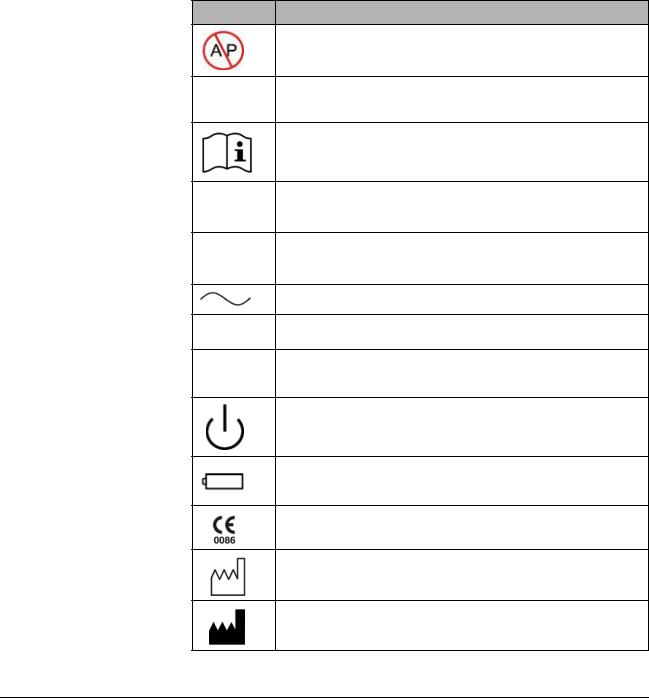
Chapter 2. Symbols
Refer to these tables to interpret symbols used on the ventilator labels and packaging and on the ventilator screen. To interpret symbols pertaining to accessories, refer to their instructions for use.
.
Table 2-1: Symbols used on ventilator labels and packaging
Symbol Description
Warning: Risk of explosion. Do not use in the presence of flammable anesthetics.
Attention, consult the accompanying documents.
Read the user manual before using the ventilator.
Protective earth (ground)
Type B applied part, which is equipment that provides a particular degree of protection against electric shock, particularly in regard to allowable leakage current and of the protective earth connection
Requires alternating current (AC)
Degree of fluid ingress protection provided by the enclosure (drip-proof)
Alarm and remote alarm
Two states of control: ON and Shutdown
Battery
European Conformity
Date of manufacture
Manufacturer
1047358 Rev A |
Respironics V60 Ventilator User Manual |
2-9 |

Chapter 2
Symbols
Table 2-1: Symbols used on ventilator labels and packaging (continued)
Symbol |
Description |
|
|
RS-232 |
RS-232 serial input/output |
|
|
|
USB port |
|
|
|
Oxygen |
|
|
|
Ethernet connection |
|
|
|
Accept button on the navigation ring |
|
|
|
Adjustment direction on the navigation ring |
|
|
|
Canadian Standards Association approval |
|
|
|
Do not disassemble. Refer to Respironics-authorized service personnel. |
|
|
|
Product must be disposed of in accordance with the WEEE directive. |
|
|
|
Noninvasive ventilation (patient with mask) |
|
|
|
Invasive ventilation (intubated patient) |
|
|
|
Do not block the cooling fan Inlet (at the rear of the ventilator). |
Hospital-grade
(On power cord)
2-10 |
Respironics V60 Ventilator User Manual |
1047358 Rev A |
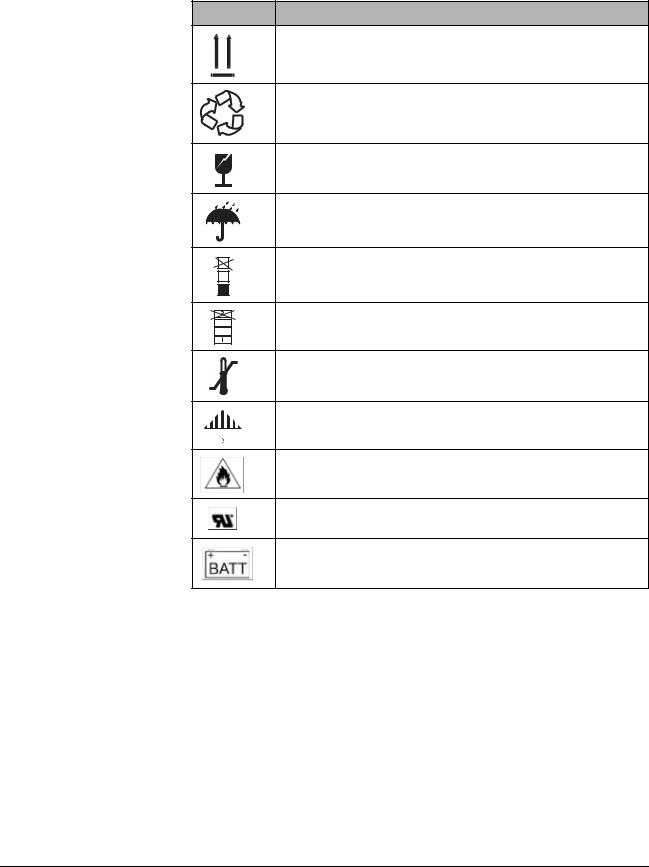
Chapter 2
Symbols
Table 2-1: Symbols used on ventilator labels and packaging (continued)
Symbol Description
This side up
Recycle
Fragile
Keep dry
Do not stack > 3 high
3
Do not stack > 7 high
50C Limit temperature to between -20 and 50 ºC (-4 and 122 ºF)
-20C
Hazmat class 9
Fire hazard
uR UL recognition symbol
Battery option
1047358 Rev A |
Respironics V60 Ventilator User Manual |
2-11 |
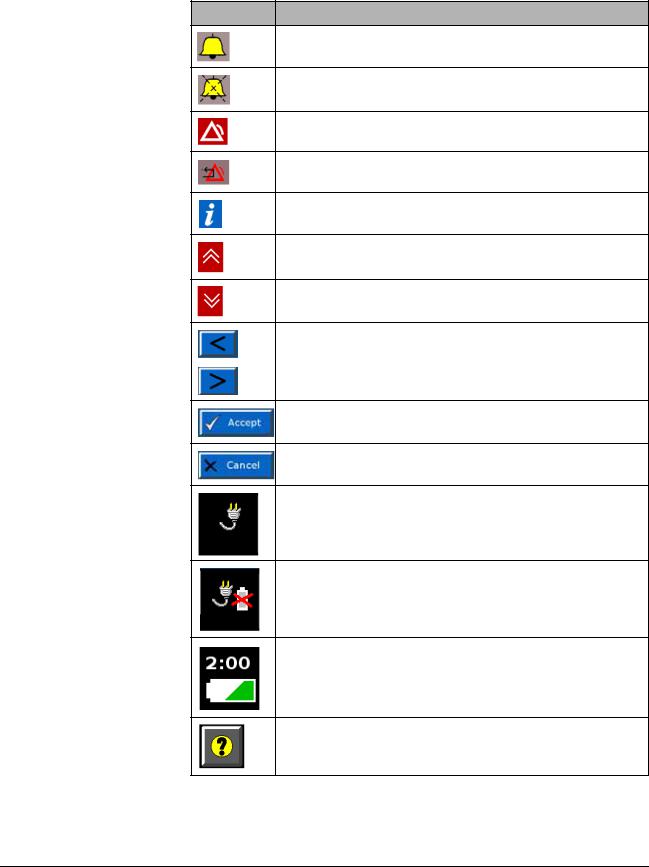
Chapter 2
Symbols
Table 2-2: Symbols used on graphical user interface
Symbol Description
Alarm (audible)
Alarm is silenced
Alarm
Alarm reset
Informational message
Alarm message is displayed. Touch to hide alarm messages.
Alarm message is hidden. Touch to display alarm messages.
Increase and decrease (adjustment arrow) buttons. Adjusts a setting or selects a value.
Accept button. Accepts set values.
Cancel button. Cancels set values.
Ventilator is powered by AC power and the optional battery is installed.
Ventilator is powered by AC power and the optional battery is not installed.
Ventilator is powered by the battery. This symbol shows the approximate battery time remaining in hours and minutes, and it shows the capacity graphically.
Help button. Touch to display onscreen help information.
2-12 |
Respironics V60 Ventilator User Manual |
1047358 Rev A |
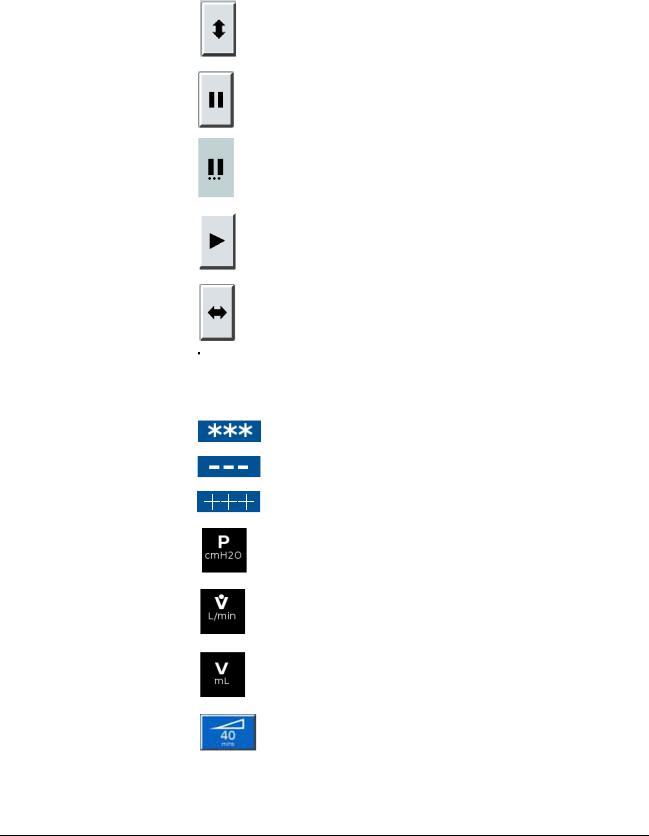
Chapter 2
Symbols
Table 2-2: Symbols used on graphical user interface (continued)
Symbol |
Description |
|
|
|
Vertical autoscale button. Autoscales the Y axis of the graphs to fit the |
|
data currently displayed. |
|
|
|
Pause button. Freezes waveforms in the Waveform window. |
|
|
|
Pause in progress |
|
|
|
Resume button. Resumes all waveform graphs from a paused state. |
|
|
|
Time base adjust button. Rescales the X axis of the graph display data at |
|
3, 6, 12, and 24 second increments. |
|
|
VE |
Estimated minute ventilation |
|
|
|
|
VT |
Estimated exhaled tidal volume |
TI/TTOT |
Duty cycle. Inspiratory time divided by total cycle time. |
|
No valid data to display |
|
|
|
Data is under range |
|
|
|
Data is over range |
|
|
|
Pressure, centimeters of water |
|
|
|
Flow, liters per minute. BTPS compensated. |
|
|
|
Volume, milliliters |
|
|
|
User-set Ramp Time. Ramp graphic fills in as Ramp Time progresses. |
|
|
1047358 Rev A |
Respironics V60 Ventilator User Manual |
2-13 |

Chapter 2
Symbols
Table 2-2: Symbols used on graphical user interface (continued)
Symbol Description
Ramp Time is OFF (no ramp time set).
Intentional leak. The number corresponds to the leak symbol printed on
Respironics masks.
2-14 |
Respironics V60 Ventilator User Manual |
1047358 Rev A |

Chapter 3. General information
Intended use
About CO2 rebreathing
Potential side effects
The Respironics V60 Ventilator is an assist ventilator and is intended to augment patient breathing. It is intended for spontaneously breathing individuals who require mechanical ventilation: patients with respiratory failure, chronic respiratory insufficiency, or obstructive sleep apnea in a hospital or other institutional settings under the direction of a physician.
The ventilator is intended to support pediatric patients weighing 20 kg (44 lb) or greater to adult patients. It is also intended for intubated patients meeting the same selection criteria as the noninvasive applications. The ventilator is intended to be used by qualified medical professionals, such as physicians, nurses, and respiratory therapists. The ventilator is intended to be used only with various combinations of Respironics-recommended patient circuits, interfaces (masks), humidifiers, and other accessories.
As with mask ventilation in general, patient CO2 rebreathing may occur under some circumstances. Follow these guidelines to minimize the potential for CO2 rebreathing. If rebreathing is a significant concern for a particular patient and these guidelines are not sufficient to acceptably reduce the potential for CO2 rebreathing, consider an alternative means of ventilation.
•Increase EPAP to decrease the potential for CO2 rebreathing. Higher pressures produce more flow through the exhalation port, which helps to purge all CO2 from the circuit to prevent rebreathing.
•Be aware that the potential for CO2 rebreathing increases as inspiratory time increases. A longer inspiratory time decreases
exhalation time, allowing less CO2 to be purged from the circuit before the next cycle. In such circumstances, higher tidal volumes further increase the volume of CO2 rebreathed by the patient.
Advise the patient to immediately report any unusual chest discomfort, shortness of breath, or severe headache. Other potential side effects of noninvasive positive pressure ventilation include: ear discomfort, conjunctivitis, skin abrasions due to mask/patient interface, and gastric distention (aerophagia). If skin irritation or breakdown develops from the use of the mask, refer to the accompanying mask instructions for appropriate action.
1047358 Rev A |
Respironics V60 Ventilator User Manual |
3-1 |
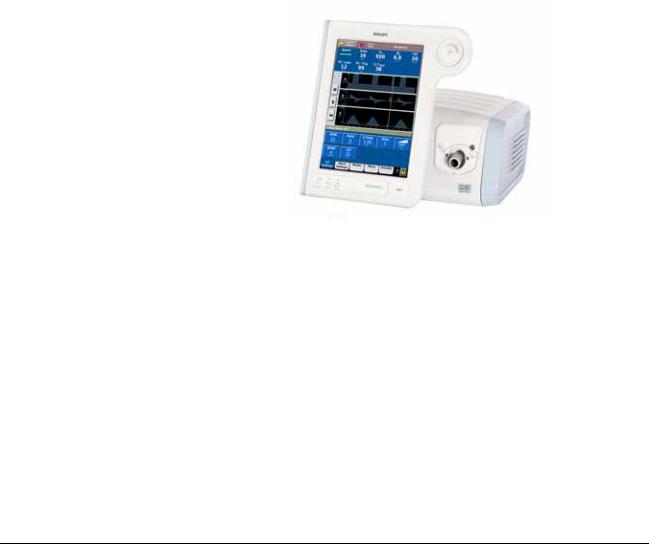
Chapter 3
General information
Contraindications
General description
The Respironics V60 Ventilator is contraindicated for patients with any of the following conditions:
•Lack of spontaneous respiratory drive
•Inability to maintain a patent airway or adequately clear secretions
•At risk for aspiration of gastric contents
•Acute sinusitis or otitis media
•Hypotension
•Untreated pertussis
•Epistaxis (nosebleed)
The Respironics V60 Ventilator (Figure 3-1) is a microprocessor-controlled, bilevel positive airway pressure (BiPAP) ventilatory assist system that provides noninvasive positive pressure ventilation (NPPV) and invasive ventilatory support for spontaneously breathing adult and pediatric patients.
Figure 3-1: Respironics V60 Ventilator
Ventilation modes. The ventilator offers a range of conventional pressure modes, CPAP (continuous positive airway pressure), PCV (pressure-controlled ventilation), and S/T (spontaneous/timed). The volume-targeted AVAPS (average volume-assured pressure support) mode combines the attributes of pressure-controlled and volume-targeted ventilation.
Auto-Trak Sensitivity allows the ventilator to automatically compensate for unintentional leaks by maintaining a stable baseline and adjusting trigger and cycle thresholds for optimum patient-to-ventilator synchrony.
User interface. The ventilator’s ergonomic design, including a 12.1-inch (31cm) color touchscreen, a navigation ring, and key panel, lets you easily access ventilator settings and monitored parameters.
3-2 |
Respironics V60 Ventilator User Manual |
1047358 Rev A |

Chapter 3
General information
Monitoring. The ventilator displays monitored parameters as numbers and as real-time waveforms (curves or scalars).
Alarms. The ventilator’s operator-adjustable and nonadjustable alarms help ensure the patient’s safety.
Power and gas supplies. The ventilator uses as its primary power source AC mains. An optional internal backup battery powers the ventilator typically for 6 hours.
The ventilator uses high-pressure oxygen. An integral blower pressurizes gas for delivery to the patient.
Mounting. The ventilator can be mounted to the universal stand. When equipped with the optional cylinder holder, the stand can accommodate two E- size oxygen cylinders.
Communications interface. The ventilator can output data through the RS-232 serial port upon receiving a command from a host computer or bedside monitoring system. The ventilator is equipped with a remote alarm/nurse call connection to activate alarms remotely.
Upgradability via Respironics Respi-Link remote diagnostic system. The RespiLink interface permits software upgrade and remote troubleshooting of the ventilator through the RS-232 port.
1047358 Rev A |
Respironics V60 Ventilator User Manual |
3-3 |
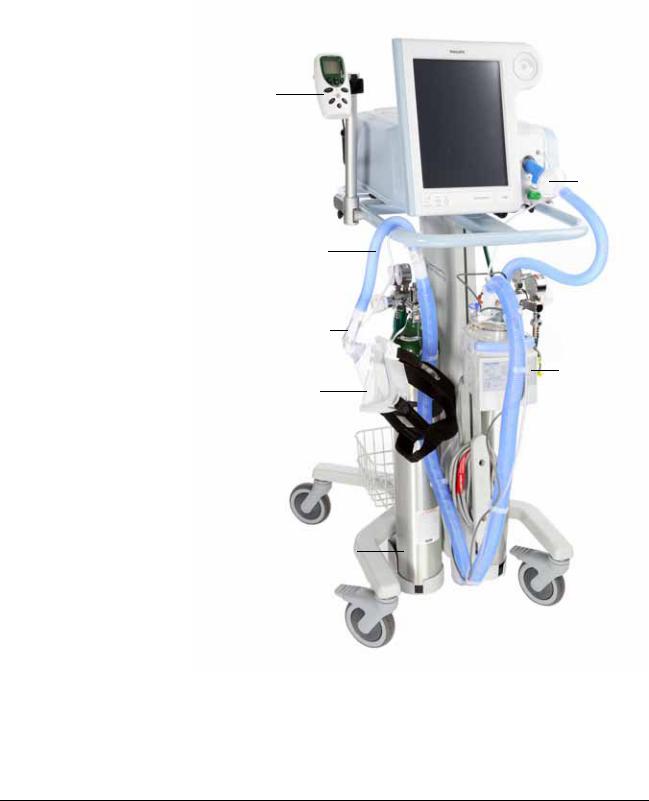
Chapter 3
General information
Physical description Patient circuits, masks/patient interfaces, and accessories
Figure 3-2 shows the Respironics V60 Ventilator with its patient circuit and accessories. Table 3-1 on page 3-5 lists recommended patient circuits, masks/ patient interfaces, and other accessories for use with the ventilator. Appendix D provides ordering information for Respironics parts and accessories.
3
Oxygen monitor
Bacteria filter
Patient circuit
Exhalation port
Humidifier
Mask
Oxygen cylinder
Figure 3-2: Respironics V60 Ventilator with accessories
3-4 |
Respironics V60 Ventilator User Manual |
1047358 Rev A |

|
Chapter 3 |
|
General information |
Table 3-1: Recommended parts and accessories |
|
|
|
Part |
Use... |
|
|
Patient circuit |
Single-limb patient circuit intended for |
|
noninvasive or invasive ventilation. To mini- |
|
mize turbulence, we recommend that you |
|
use smooth-bore tubing. Use a Respironics |
|
circuit listed in Appendix D or the equiva- |
|
lent. |
|
|
Patient interface (noninvasive or invasive) |
• Respironics masks listed in Appendix D |
|
• Invasive interface (tracheostomy or ET |
|
tube) |
|
|
Exhalation port |
Respironics exhalation port listed in Appen- |
|
dix D or the equivalent |
|
|
Inspiratory filter |
Respironics main flow (inspiratory) bacteria |
|
filter listed in Appendix D or the equivalent |
|
|
Humidifier |
• Fisher & Paykel MR810 or MR850 |
|
• Hudson RCI CONCHATHERM or |
|
CONCHATHERM Neptune |
|
|
Oxygen monitor |
• CRITERION OxiCheck oxygen analyzer |
|
(PN 8-100661-00) |
|
• Teledyne MX300 oxygen monitor |
|
• An equivalent that complies with ISO |
|
7767 |
|
|
1047358 Rev A |
Respironics V60 Ventilator User Manual |
3-5 |
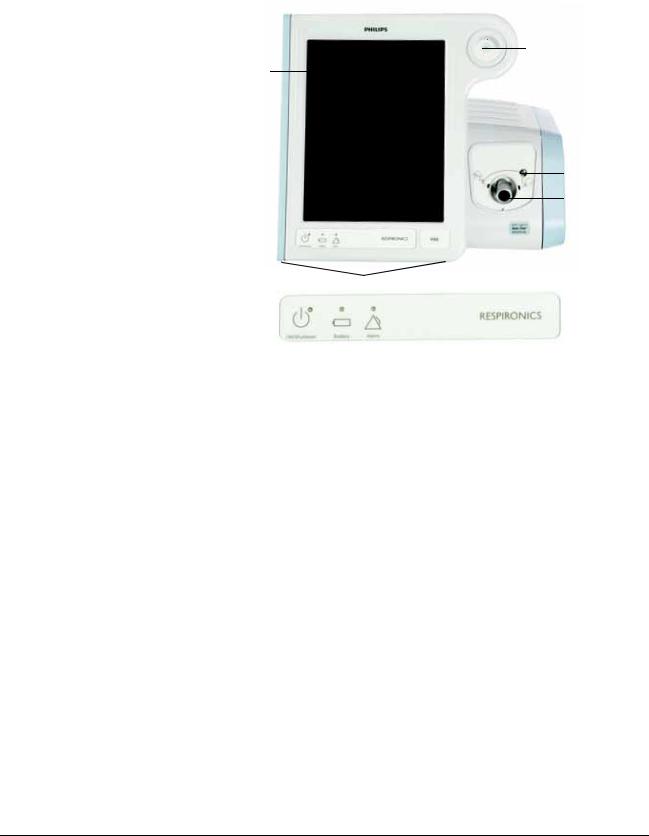
Chapter 3
General information
Ventilator unit
Figure 3-3 through Figure 3-5 show the controls, indicators, and other important parts of the ventilator unit.
 2 3
2 3
1
4
5
6
|
9 |
8 |
7 |
|
|
|
Key panel |
|
|
|
Figure 3-3: Front view |
|
|
|
|
Number |
Description |
|
|
|
|
||
1 |
Graphical user interface. Color LCD (liquid crystal display) with touchscreen. |
||
|
|
||
2 |
Navigation ring. Lets you adjust values and navigate the graphical user interface |
||
|
by rotating the finger on its touchpad. |
||
|
|
||
3 |
Accept button. Activates selections. |
||
|
|
||
4 |
Proximal pressure port. Connection for tubing that monitors patient pressure in |
||
|
the patient circuit. |
|
|
|
|
||
5 |
Ventilator outlet (To patient) port. Main connection for the patient circuit. Deliv- |
||
|
ers air and oxygen in prescribed pressures to the patient. |
||
|
|
||
6 |
Alarm speakers (beneath ventilator) |
||
|
|
||
7 |
Alarm LED. Flashes during a high-priority alarm. On continuously during a venti- |
||
|
lator inoperative condition. |
||
|
|
||
8 |
Battery (charged) LED. Flashes when battery is charging. On continuously when |
||
|
battery is charged. Off when ventilator is running on battery or when the venti- |
||
|
lator is off and AC power is not connected. |
||
|
|
||
9 |
ON/Shutdown key with LED. Turns on AC power and initiates ventilator shutdown. |
||
|
LED is continuously on when AC power is connected. |
||
|
|
|
|
3-6 |
Respironics V60 Ventilator User Manual |
1047358 Rev A |
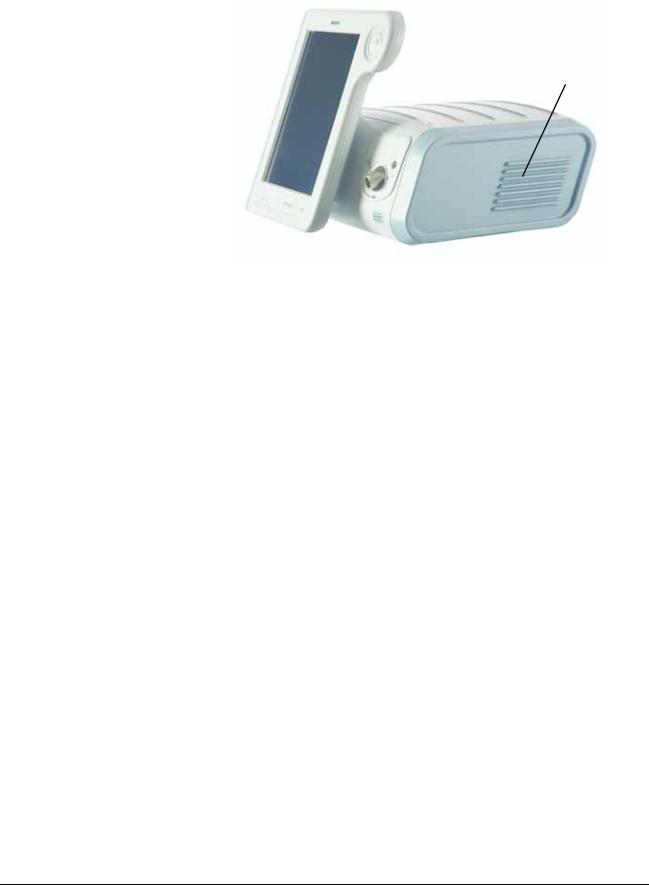
Chapter 3
General information
1
2
|
Figure 3-4: Side view |
|
|
Number |
Description |
|
|
1 |
Ventilation vents. Allow intake of air for delivery to the patient. |
|
|
2 |
Air inlet filter (under side panel). Filters the air for delivery to the patient. |
|
|
1047358 Rev A |
Respironics V60 Ventilator User Manual |
3-7 |

Chapter 3
General information
1
|
8 |
7 3 |
3 |
6 |
5 4 3 2 |
|
|
Figure 3-5: Rear view |
|||
|
|
|
|
|
|
Number |
Description |
|
|
|
|
|
|
||||
1 |
Backup battery (compartment under side panel). Optional, 6-hour backup bat- |
||||
|
tery. |
|
|
|
|
|
|
|
|||
2 |
Remote alarm/nurse call connector |
|
|||
|
|
|
|
|
|
3 |
Reserved for future use |
|
|
|
|
|
|
|
|
|
|
4 |
Power cord retainer |
|
|
|
|
|
|
|
|
|
|
5 |
Power cord |
|
|
|
|
|
|
||||
6 |
RS-232 serial and analog I/O connector (female DB-25). Connects to hospital |
||||
|
information systems and other serial devices, and functions as an interface |
||||
|
for analog signals. Connects Respi-Link remote diagnostic system gateway |
||||
|
for software updates. |
|
|
|
|
|
|
|
|
|
|
7 |
Cooling fan filter |
|
|
|
|
|
|
|
|||
8 |
High-pressure oxygen inlet connector |
|
|||
|
|
|
|
|
|
3-8 |
Respironics V60 Ventilator User Manual |
1047358 Rev A |
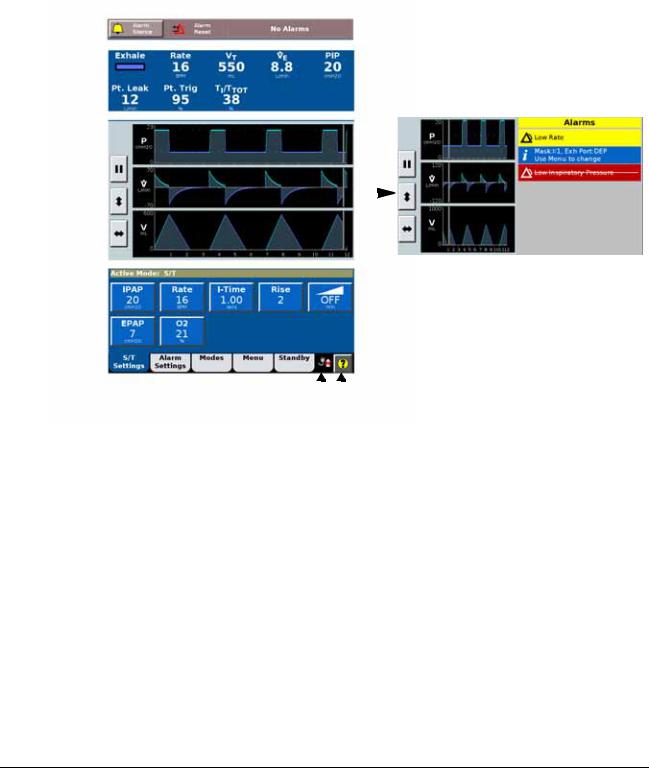
Chapter 3
General information
Graphical user interface
Through the graphical user interface (Figure 3-6) you make ventilator settings and view ventilator and patient data. During ventilation, the upper screen displays alarms and patient data. The middle screen displays real-time waveforms and alarm and informational messages. The lower screen lets you access modes and other ventilator settings, display help information, and see the power status.
.
Alarm status bar (see page 8-2)
Patient data window (see page 7-1)
Waveforms window |
15 |
|
|
|
|
(see page 7-1) |
|
|
|
|
|
|
|
|
|
|
|
Compressed waveforms window with Alarms/ Messages list
(see page 8-2)
Window/window tabs (see page 6-1)
|
|
|
|
Power symbols |
Help button |
||
(see page 5-5) |
(see page 6-14) |
||
Figure 3-6: Parts of graphical user interface
1047358 Rev A |
Respironics V60 Ventilator User Manual |
3-9 |

Chapter 3
General information
(This page is intentionally blank.)
3-10 |
Respironics V60 Ventilator User Manual |
1047358 Rev A |
